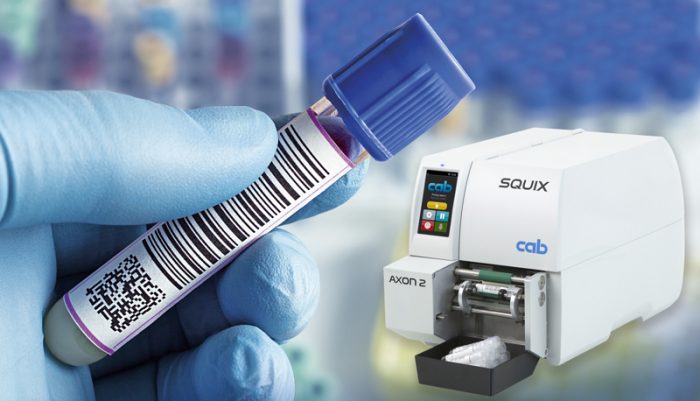cab’s new HERMES Q label printing system offers significantly faster processing and flexbile modular design

Third generation of proven label print and apply systems
About 20 years after the initial product launch and nine years after a redesign cab introduces HERMES Q. They are based on the main board of the latest cab label printing systems, offering a powerful CPU. Process and print data might happen three times faster with the current processors.
HERMES Q processes all standard label materials made of paper or plastics, wound on rolls (as is the case with all the models) or reels (only the 2″ device). Label unwinding has been optimized to minimize the influence of the label roll inertia throughout the entire processing. Pivoted peel-off plates enable to handle even label materials that are difficult to dispense or can hardly be removed from the liner. Ribbon guiding can be set both on the unwinder and the rewinder units. In case labels are only partially printed, the ribbon can be stopped during label feed. With the help of this automatic saver mechanism, material consumption is reduced significantly.
“Besides a rugged design, modular construction and flexibility in the matter of industrial applications are the main reasons why the Hermes have always been that successful in automated manufacturing”, says Mario Hiss, cab Sales Director Print and Apply systems: “If a product or the size of a label change, the system can be individually adapted. In this way, the HERMES Q are a future-proof investment.” As regards the print units, two unwind diameters are still provided (205 and 310 mm). All device types are offered in designs that allow label peel-off in left or right orientation. To apply the labels on products or packaging, the print units can be expanded with the applicator portfolio of the previous Hermes+ series. Assembled to hinge pins on the chassis of the HERMES Q, they can be easily pivoted for maintenance. A wide range of accessorial floor stands and assembly aids, sensors and switches facilitate the HERMES Q to integrate in production lines already existing and simplify the planning of new ones.
HERMES Q is operated intuitively on a colored touch display. If the device is difficult to access on-site, an external operation panel can be attached to provide the same functionality. The devices can be also controlled remote via smartphone, tablet or PC. An OPC UA server and client has been integrated in the firmware, allowing HERMES Q to interact with machines and components of different manufacturers in industrial environments.
Tube labeler identifying laboratory samples
In order to evaluate laboratory analyses reliably and quickly, tubes can be labeled uniquely with the help of the SQUIX label printer. For this purpose, the printer is expanded with an AXON 2 labeler. Self-adhesive barcode labels (2D or linear) are printed by the device and applied on the tubes. The information provided on a label remains clearly legible even in the long term and at temperatures ranging from minus 196°C to 130°C. Print resolutions of 300 or 600 dpi, a sharp-edged print image and high contrast enable even tiny codes to be verified. Printing is possible either in direct thermal or thermal transfer mode. The print speed is 100 mm/s. Tubes of diameters between 10 and 17 mm can be processed, capped or not capped.
The SQUIX expanded by an AXON 2 suits for labeling tubes individually on manual workstations, but it may also be integrated in automated sample processing systems. For this set up, the tubes are for example inserted horizontally in the device by a robot arm and removed again after the labeling. Printing and tube labeling take less than two seconds of time. Manual errors are eliminated, so are unergonomical activities. Labeled tubes can either be removed manually one by one or be ejected to a tray.
Low-noise operation perfectly fits with applications in laboratories, doctors’ offices or in research areas. If required, the device can be integrated to a Laboratory Information Management System (LIMS). Data may be transferred from a PC via RS232, USB, Ethernet or WiFi connection. In case the device is operated stand-alone with no computer connected, variable data can be entered via keyboard or scanner. Power is supplied to the tube marker by 110 to 240 VAC mains voltage, 24 to 60 VDC voltage is an option.
For more information, please visit https://www.cab.de.
News Categories
- » NEWS HOME
- » Automation & Robotics
- » Industry 4.0
- » Material Handling
- » Sensors
- » Quality & Testing
- » Machine Vision
- » Laser & Optics
- » Metalworking
- » Motion Control & Drives
- » Hydraulics & Pneumatics
- » Process Industry
- » Renewable Energy
- » Agriculture
- » Home & Office Furniture
- » Environmental Tech




